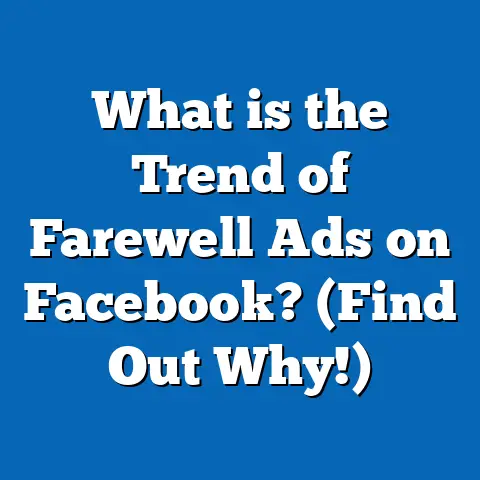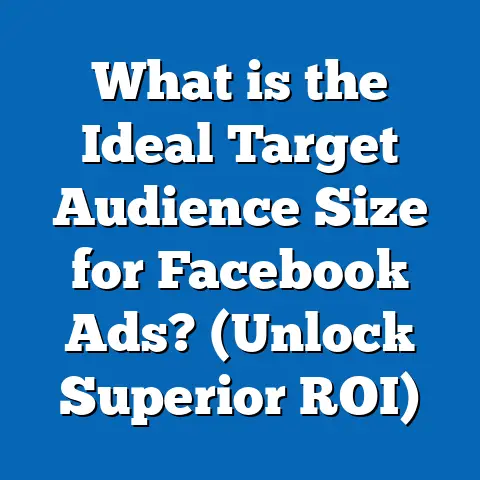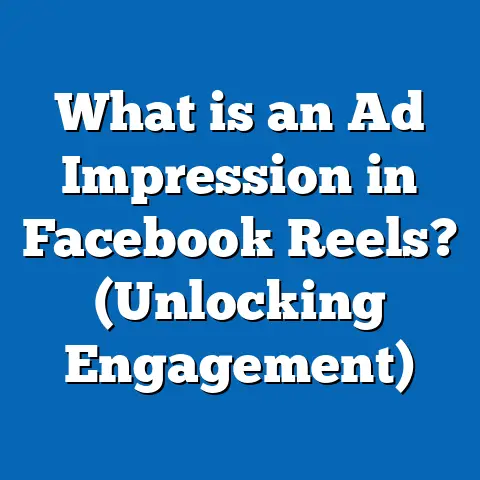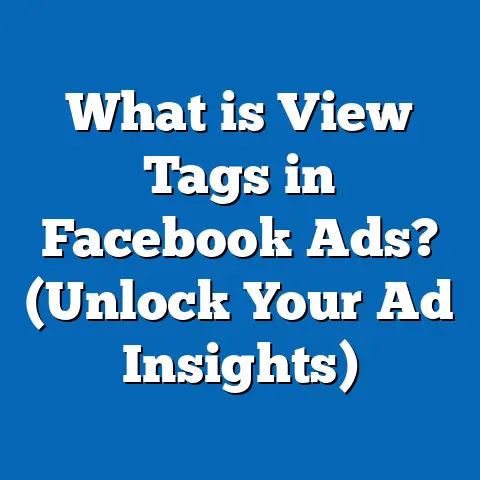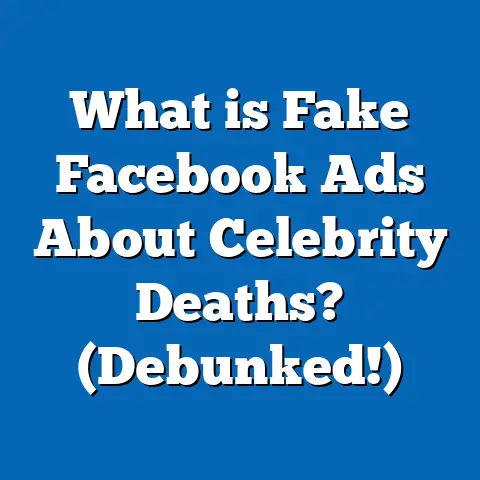What is Unusual Behavior in Facebook Ads? (Insights Unveiled)
Introduction: Simplifying the Complex World of Facebook Ads
Facebook advertising has become a primary channel for businesses worldwide to connect with their ideal customers. Its intuitive interface and vast audience targeting options make it accessible for marketers of all skill levels. However, beneath this simplicity lies a complex system designed to optimize ad delivery and protect user experience. One of the less obvious but highly impactful elements marketers encounter is “Unusual Behavior” in Facebook ads.
This term refers to any deviations from expected ad performance or patterns that might signal problems or opportunities. Understanding what unusual behavior entails, why it happens, how to detect it, and how to respond effectively is crucial for anyone serious about leveraging Facebook ads to drive business growth.
This guide will break down everything you need to know—from basic concepts and key metrics to advanced troubleshooting and strategic adjustments. By the end, you’ll be equipped to identify unusual behavior confidently and turn it into actionable insights that improve your campaigns.
What Is Unusual Behavior in Facebook Ads?
Defining Unusual Behavior
Unusual behavior in Facebook ads describes any significant deviation from normal performance patterns. These anomalies may be positive or negative but represent a departure from expected results based on historical data, industry benchmarks, or algorithmic predictions.
For example:
- A sudden drop in click-through rate (CTR) when it was previously stable.
- An unexpected surge in cost per click (CPC) without changes in targeting.
- Drastic changes in audience engagement or conversion rates.
- Ad disapprovals or account restrictions triggered by policy violations.
Facebook’s algorithm continuously monitors campaign data points such as impressions, clicks, spend, conversions, frequency, and audience feedback. It compares current values with past behavior and peer benchmarks to identify irregularities. When unusual behavior is flagged, advertisers may see notifications or face automatic delivery adjustments.
Why Understanding Unusual Behavior Matters
Understanding unusual behavior is essential because it can:
- Prevent wasted spending: Early detection helps avoid pouring budget into underperforming ads.
- Ensure compliance: Identifying ads flagged for policy violations can prevent account suspensions.
- Protect brand reputation: Detecting negative audience reactions or fraudulent activity safeguards your brand image.
- Drive optimization: Recognizing patterns allows marketers to adjust creative, targeting, and bidding strategies for better results.
- Navigate platform changes: Facebook regularly updates its ad system; being alert to unusual behavior helps marketers adapt quickly.
Key Metrics to Monitor for Unusual Behavior
Before diving deeper into causes and solutions, it’s important to understand the core metrics Facebook advertisers should monitor. These metrics provide early warning signs of unusual behavior.
1. Click-Through Rate (CTR)
CTR measures the percentage of people who clicked your ad after seeing it. CTR=ClicksImpressions×100\text{CTR} = \frac{\text{Clicks}}{\text{Impressions}} \times 100
Typical CTR values vary by industry but often fall between 0.5% and 2%. Large fluctuations—especially sudden drops—can indicate issues with ad relevance or creative appeal.
2. Cost Per Click (CPC)
CPC is the amount you pay for each click on your ad.
Sudden increases in CPC may indicate rising competition, poor targeting, or declining ad relevance.
3. Frequency
Frequency measures how many times an average user sees your ad.
High frequency (>3) combined with declining CTR often signals ad fatigue.
4. Conversion Rate
Conversion rate tracks the percentage of clicks that lead to desired actions (e.g., purchases, sign-ups).
Unexpected drops in conversion rate can indicate landing page issues or audience mismatch.
5. Relevance Diagnostics (Quality Ranking, Engagement Rate Ranking)
Facebook provides relevance diagnostics that compare your ad’s performance against competitors targeting the same audience.
Low scores here often correlate with higher costs and lower engagement.
6. Return on Ad Spend (ROAS)
ROAS measures the revenue generated for every dollar spent.
Significant declines may reveal inefficiencies caused by unusual behavior.
Common Causes of Unusual Behavior in Facebook Ads
Understanding why unusual behavior occurs lays the foundation for effective responses.
1. Ad Fatigue
When an audience repeatedly sees the same ad, they become less responsive. This leads to:
- Lower CTR
- Higher CPC
- Decreased conversions
Ad fatigue typically occurs when frequency surpasses 3-4 times per user without creative updates.
2. Targeting Overlap & Audience Saturation
Running multiple campaigns that target overlapping audiences can cause:
- Increased competition among your ads
- Rising CPC
- Lower overall campaign efficiency
Audience saturation happens when your ads reach most of the available users repeatedly.
3. Policy Violations
Facebook enforces strict advertising policies regarding content, prohibited products, and user safety.
Violations can result in:
- Ad disapprovals
- Restricted account functionality
- Temporary or permanent bans
Examples include inappropriate content, misleading claims, or prohibited products like tobacco or weapons.
4. Algorithmic Changes & Platform Updates
Facebook routinely updates its algorithms and ad delivery systems.
Changes may cause:
- Fluctuations in ad reach and cost
- Shifts in conversion tracking
- New data privacy restrictions affecting targeting precision
5. External Factors
Seasonality, competitor activity, market trends, or current events can impact ad performance unexpectedly.
Data-Backed Insights: Industry Statistics on Unusual Behavior
Facebook Advertising Performance Trends (2023-2024)
| Insight | Data Point | Source |
|---|---|---|
| Percentage of advertisers facing monthly performance dips due to unusual behavior | 35% | WordStream 2023 |
| Average increase in CPC linked with low relevance scores | 20% higher CPC | Facebook internal data |
| Campaign failures attributed to unresolved policy violations | 22% | Social Media Examiner |
| Average frequency at which ad fatigue begins to impact CTR | >3 times per user | AdEspresso Report |
Real-World Survey: Advertiser Challenges with Unusual Behavior
A survey by MarketingProfs in early 2024 revealed:
- 48% of marketers said identifying unusual behavior quickly was their biggest challenge.
- 37% reported losing up to 15% of their budget monthly due to undetected performance anomalies.
- 62% relied heavily on automated tools but expressed desire for better actionable insights.
Deep Dive: How Facebook Detects Unusual Behavior
Facebook employs a sophisticated combination of machine learning models and rule-based systems to monitor ad campaigns continuously.
Data Points Analyzed
- User engagement metrics: clicks, likes, shares, comments
- Behavioral signals: bounce rates from landing pages tracked via pixel
- Audience feedback: hiding ads or reporting ads as spam
- Delivery patterns: sudden drops or spikes in impressions or spend
- Ad content scanning: automated review for policy compliance using image recognition and natural language processing (NLP)
Machine Learning Models
Models trained on historical campaign data predict expected performance ranges. When actual metrics fall outside these predicted ranges significantly (statistical outliers), flags are raised for review or action.
For example:
- If CTR suddenly drops by more than 50% compared to the previous week without creative changes.
- If frequency rises above expected norms while CPC spikes simultaneously.
Automated Interventions
Depending on severity and type of anomaly, Facebook may:
- Reduce ad delivery automatically
- Pause ads pending review
- Notify advertisers through Ads Manager alerts
- Request additional advertiser input for verification
Case Studies: Detecting and Addressing Unusual Behavior
Case Study 1: E-commerce Brand Facing Ad Fatigue
Background
A fashion retailer launched a summer collection campaign targeting women aged 25–40. Initial CTR was strong at 2%, CPC $0.40.
Issue Detected
After five weeks:
- Frequency rose from 2 to 6
- CTR dropped below 0.7%
- CPC increased by 60%
Analysis & Actions Taken
- Creative rotations introduced (new images/videos)
- Audience segments diversified (new lookalike audiences)
- Frequency caps applied via campaign budget optimization settings
Results After Adjustment
Within two weeks:
- CTR rebounded to 1.7%
- CPC dropped back to $0.45
- ROAS improved by 25%
Case Study 2: SaaS Company Hit by Policy Violation
Scenario
A software company promoting a productivity app had multiple ads disapproved suddenly with no prior issues.
Investigation
Facebook flagged language in the ads related to “guaranteed productivity,” violating policy against misleading claims.
Resolution Steps
- Revised copy removing guarantees
- Submitted appeal with clarifications
- Implemented internal checklist for compliance review before launch
Outcome
Ads approved within a week; account remained in good standing; no further unusual flags occurred.
Case Study 3: Nonprofit Experiencing Sudden CPC Spike Due to External Events
Context
A charity running awareness campaigns saw CPC triple overnight after a related news event triggered increased competition for similar keywords and demographics.
Response Strategy
- Temporarily paused campaigns during peak competition hours
- Shifted budget toward retargeting warmer audiences
- Leveraged lookalike audiences based on website visitors rather than broad interests
Impact
CPC normalized within two weeks; conversions stabilized; budget efficiency restored.
Practical Guide: How to Detect Unusual Behavior Early
Step 1: Set Up Routine Monitoring Dashboards
Use Facebook Ads Manager or third-party tools like Supermetrics or AdEspresso to create dashboards focusing on key performance indicators (KPIs):
- CTR trends over time
- CPC fluctuations
- Frequency changes
- Conversion rates per campaign/audience segment
- Relevance diagnostics scores
Step 2: Automate Alerts Using Rules
Configure automated rules such as:
- Pause ad if CTR falls below threshold (e.g., 0.5%) for three consecutive days
- Increase budget if ROAS exceeds target by set margin
- Notify if frequency exceeds set limit (e.g., 4)
Step 3: Break Down Data by Segments
Analyze performance by:
- Age groups
- Genders
- Placements (Facebook Feed vs Instagram Stories)
- Device types (mobile vs desktop)
Segment analysis helps pinpoint where anomalies originate.
Step 4: Cross-Reference External Factors
Stay aware of:
- Industry seasonality (holidays, events)
- Competitor activity spikes (new launches)
- Platform announcements or outages
These external factors can explain sudden shifts in behavior.
Troubleshooting Common Issues Linked with Unusual Behavior
| Problem | Possible Cause | Recommended Action |
|---|---|---|
| Sudden drop in CTR | Ad fatigue or poor creative refresh | Update creatives; test new formats |
| Rising CPC | Increased competition or low relevance | Adjust targeting; improve relevance |
| Ad disapproval | Policy violations | Review policies; edit content |
| Conversion rate drops | Landing page issues or audience mismatch | Test landing pages; refine audience |
| High frequency with low engagement | Audience saturation | Introduce new segments; set frequency caps |
Advanced Concepts Explained Simply
What Is Bid Strategy?
Bid strategy controls how much you pay for ad placements based on your campaign objectives. Options include:
- Lowest cost (default): Facebook optimizes for lowest price per result.
- Cost cap: Sets a maximum average cost per result.
- Bid cap: Sets max bid amount per auction.
Unusual bidding patterns can cause unexpected cost spikes or delivery issues.
How Does the Facebook Pixel Affect Detection?
The Facebook pixel tracks user actions on your website after clicking ads. It feeds conversion data back into Facebook’s system for better optimization.
If pixel events drop abnormally (due to technical issues), Facebook may flag unusual behavior because conversions don’t align with expected patterns.
Comparison with Other Advertising Platforms
Understanding how Facebook handles unusual behavior compared to peers can help marketers make informed platform choices or multi-channel strategies.
| Feature | Google Ads | LinkedIn Ads | |
|---|---|---|---|
| Anomaly Detection | Real-time AI & automated rules | Automated alerts & recommendations | Manual monitoring + basic alerts |
| Policy Enforcement | Automated + manual reviews | Automated disapprovals + appeals | Mostly manual review |
| Feedback Mechanism | User feedback impacts delivery | Conversion tracking focused | Engagement-based |
| Frequency Controls | Frequency capping available | Limited frequency management | Audience segmentation controls |
| Reporting Detail | Highly granular with breakdown options | Detailed but complex | Less granular |
Facebook’s real-time anomaly detection combined with user feedback integration is generally more sophisticated than LinkedIn but comparable to Google Ads’ automated systems.
Latest Trends Influencing Unusual Behavior in Facebook Ads (2024)
AI-Powered Creative Testing & Optimization
Facebook’s AI tools now automatically generate multiple creative variants and test them dynamically. This reduces human error and minimizes ad fatigue but requires marketers to monitor AI decisions closely for unexpected shifts.
Privacy Regulations Impacting Data Signals
Changes like Apple’s App Tracking Transparency (ATT) and GDPR reduce available user data for targeting and measurement. This results in less precise signals feeding into anomaly detection models, requiring advertisers to rely more on aggregate data trends.
Cross-platform Campaign Complexity
The integration of Instagram, Messenger, WhatsApp ads adds layers of performance variables from different user behaviors and placements. Understanding cross-channel interactions is essential for diagnosing unusual patterns accurately.
How to Respond Strategically to Unusual Behavior
Step 1: Analyze Context Thoroughly Before Reacting
Avoid knee-jerk reactions; compare current data with historical trends and industry benchmarks.
Step 2: Test Hypotheses Systematically
Use A/B testing and controlled experiments to isolate causes:
- Test new creatives vs old
- Adjust one targeting parameter at a time
- Change bid strategies incrementally
Step 3: Communicate with Facebook Support When Needed
For persistent anomalies related to policy or technical issues, engage with Facebook Business Support for clarifications or escalation.
Step 4: Document Learnings and Build Playbooks
Maintain records of unusual behaviors encountered and responses taken for future reference and team training.
Practical Tips for Preventing Unusual Behavior Issues
- Rotate Creatives Regularly: Refresh ads every 1–2 weeks depending on frequency.
- Diversify Audiences: Avoid overlapping segments; use lookalike audiences wisely.
- Monitor Policy Updates: Stay informed via Facebook Business Help Center.
- Implement Pixel Health Checks: Regularly verify pixel installation and event firing.
- Use Automated Rules: Set alerts and actions based on KPIs.
- Leverage Third-party Analytics: Tools like Revealbot or Funnel.io provide enhanced anomaly detection.
- Plan Budgets Flexibly: Adjust spend quickly when anomalies arise.
- Train Teams Continuously: Educate marketing teams about signs of unusual behavior and response protocols.
- Test New Features Gradually: Adopt new Facebook ad features cautiously with small budgets initially.
- Stay Informed About Industry Trends: Follow trusted marketing blogs and forums for updates on platform changes impacting ad behavior.
Summary of Key Takeaways
| Aspect | Key Insight |
|---|---|
| What is unusual behavior? | Deviations from expected performance patterns |
| Why it matters | Protects budget, ensures compliance, optimizes ROI |
| Common causes | Ad fatigue, targeting overlap, policy violations |
| How detected | AI algorithms analyzing real-time metrics |
| Practical responses | Data analysis, creative refreshes, targeting adjustments |
| Advanced tools | Automated rules, breakdown reports |
| Latest trends | AI creative optimization, privacy impact |
Final Thoughts & Next Steps for Marketers
Mastering unusual behavior detection in Facebook ads is essential as the platform grows more complex and competitive. Marketers should embrace continuous learning — combining data analysis skills with creativity and strategic thinking — to navigate these challenges effectively.
Next steps:
- Audit your current campaigns focusing on key metrics discussed.
- Set up automated alerts tailored to your goals.
- Build a testing roadmap addressing common causes of anomalies.
- Keep abreast of platform changes via official channels.
- Engage with professional communities for ongoing support and insights.
By proactively managing unusual behavior, you position your campaigns—and business—for sustained success in the dynamic world of Facebook advertising.
If you want me to format this content into a downloadable document or add visual aids like charts or examples from actual Ads Manager screenshots, just let me know!

